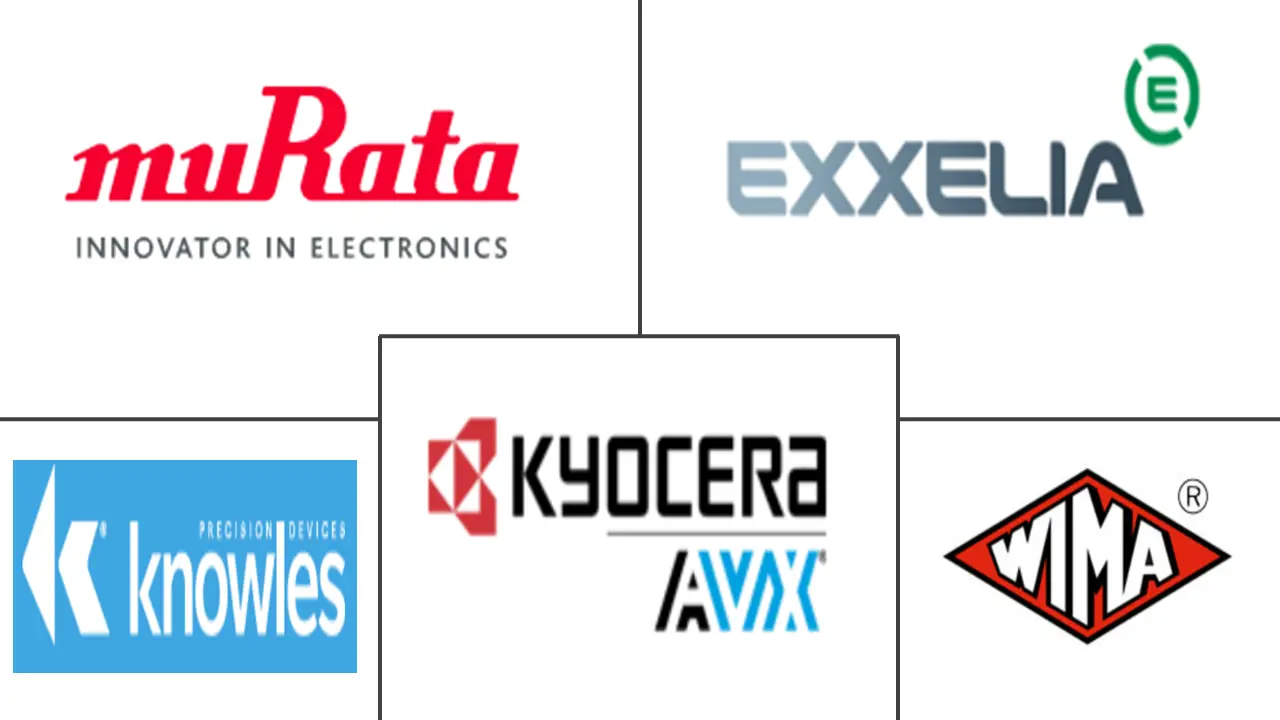Size and Share of Capacitors Market For Medical Devices
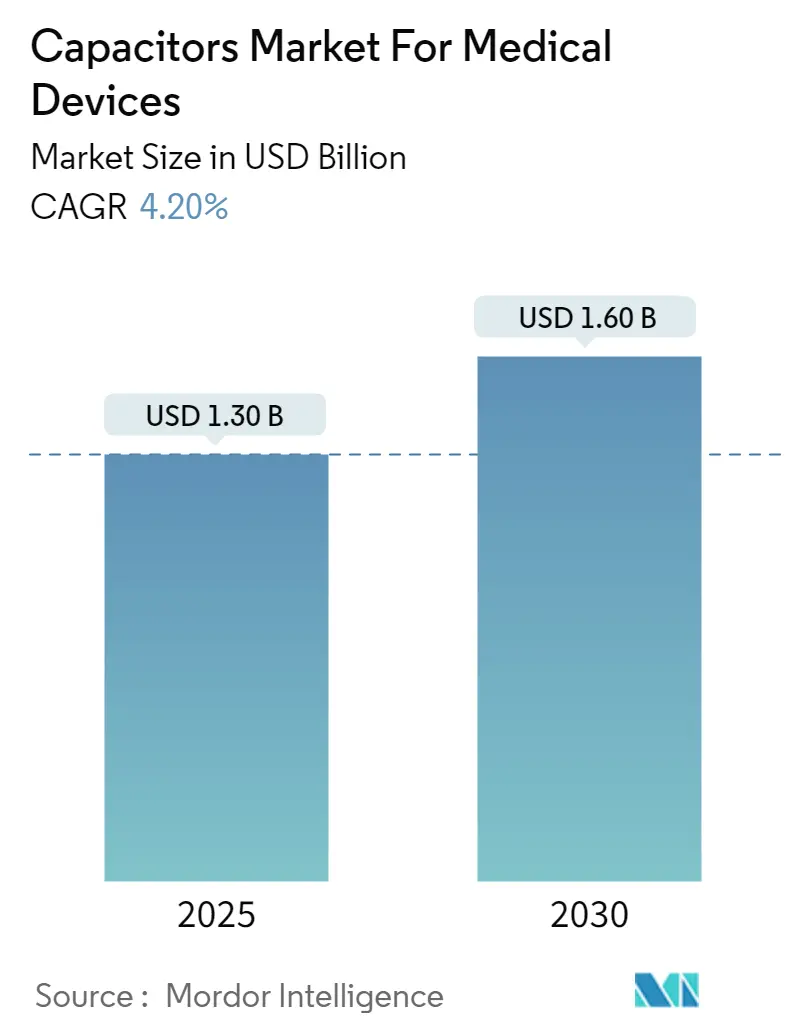
Analysis of Capacitors Market For Medical Devices by Mordor Intelligence
The Capacitors Market For Medical Devices Industry is expected to grow from USD 1.30 billion in 2025 to USD 1.60 billion by 2030, at a CAGR of 4.2% during the forecast period (2025-2030).
In diagnostic, imaging, patient monitoring, medication administration, and dispensing applications, passive components play a significant role in medical systems. For instance, implanted medical electronics are often powered by batteries or capacitors that must be removed from the body once they have served their purpose since they are not biodegradable.
- Capacitors are used in implanted medical equipment like pacemakers, insulin pumps, and defibrillators, as well as portable and wearable ones like electrocardiograms, ultrasound echo machines, and blood gas analyzers. High dependability, a long service life, and passing rigorous screening tests are all requirements. Today, meeting consumer demand frequently entails miniaturization, capacitor design, and material improvements.
- Electronic devices such as bionic implants or artificial organs perform like biological organisms. The artificial kidney, bio-lung, and artificial pancreas are a few well-known medical bionics currently being produced or developed. The need for medical electronics in the class-III device category is being driven by the expanding elderly population, which is also propelling technological breakthroughs in the field of bionic implants.
- Along with implantables, the need for portable and wearable medical technology has grown as medicine starts to leave the confines of the traditional environment. To improve patients' quality of life, conventional benchtop equipment are being downsized and become increasingly wearable and implantable. For instance, a conventional cochlear implant gives patients who are profoundly deaf a feeling of sound. The implant is a little device, therefore using a more portable, high-reliability capacitor is necessary for this size range. These trends will drive the market growth for the capacitors in manufacturing the medical devices.
- The cost of raw materials, which is a variable cost, is the highest one involved in the manufacture of capacitors. Profit margins may suffer from changes in price or availability for these essential feedstocks. Tantalum capacitors are often chosen for applications with capacitance ranges at or above 10 μF in the medical industry, whereas MLCCs are typically thought to be the best option for applications with capacitance ranges below 1 μF. It is anticipated that in 2023, the cost of the metals like copper, Nickel is continue to rise which can impact the production of required capacitors during the projected period.
Insights and Trends of Capacitors Market For Medical Devices
Multilayer Ceramic Capacitors (MLCC) are Significantly Used in the Medical Devices
- MLCCs are appealing for medical equipment applications due to their compact size, excellent durability, huge capacity, and predictable temperature coefficients. In terms of applied voltage, they also provide the most constant capacitance.
- MLCC technology can manufacture them at case sizes that are not practicable for tantalum capacitors. DC leakage current (DCL) is one of the most crucial electrical characteristics of tantalum capacitors. Tantalum capacitors have higher leakage currents than ceramic capacitors. This is one of the main justifications for MLCC use, particularly in the production of medical equipment.
- According to WHO, the most significant cause of mortality worldwide is cardiovascular diseases (CVDs), which claim 17.9 million lives annually. Pacemakers and defibrillators are highly required for those patients, and these equipment are manufactured using MLCC.
- ICDs and pacemakers must be as tiny as feasible because they are both within the body. The creation of new leadless pacemakers around 1/10th the size of a conventional pacemaker is currently being worked on by medical device designers, who are concentrating on developing innovative device designs to reduce the size further. Therefore, it is necessary to continue miniaturizing the electrical parts utilized in these devices, such as capacitors, which may be tricky.
- Using multi-layer ceramic capacitors (MLCCs) is a beautiful way to minimize capacitor size. An MLCC allows for constructing many layers within a single capacitor, producing a single capacitor that offers a capacitance level comparable to employing multiple SLCs linked in parallel. This multi-layer design reduces the total footprint needed for a capacitor to reach the greater capacitance required for pacemakers and ICDs, although being somewhat thicker (taller) than an SLC.
- For instance, Pacemakers and implanted cardioverter defibrillators (ICDs) are essential life-saving medical devices that more than 3 million patients in the United States use. Both implants are medical devices for improving the quality of life for persons with cardiac arrhythmia.
- According to the Australian Bureau of Statistics, the country had 4,099 deaths certified by the doctors as of February 2024, which has increased from 3,858 as compared to 2023. As the new-age population believes in medical technology over traditional treatment to lead a healthy quality of life, more advanced medical devices are under development and, therefore, will drive the demand for capacitors during the projected period.
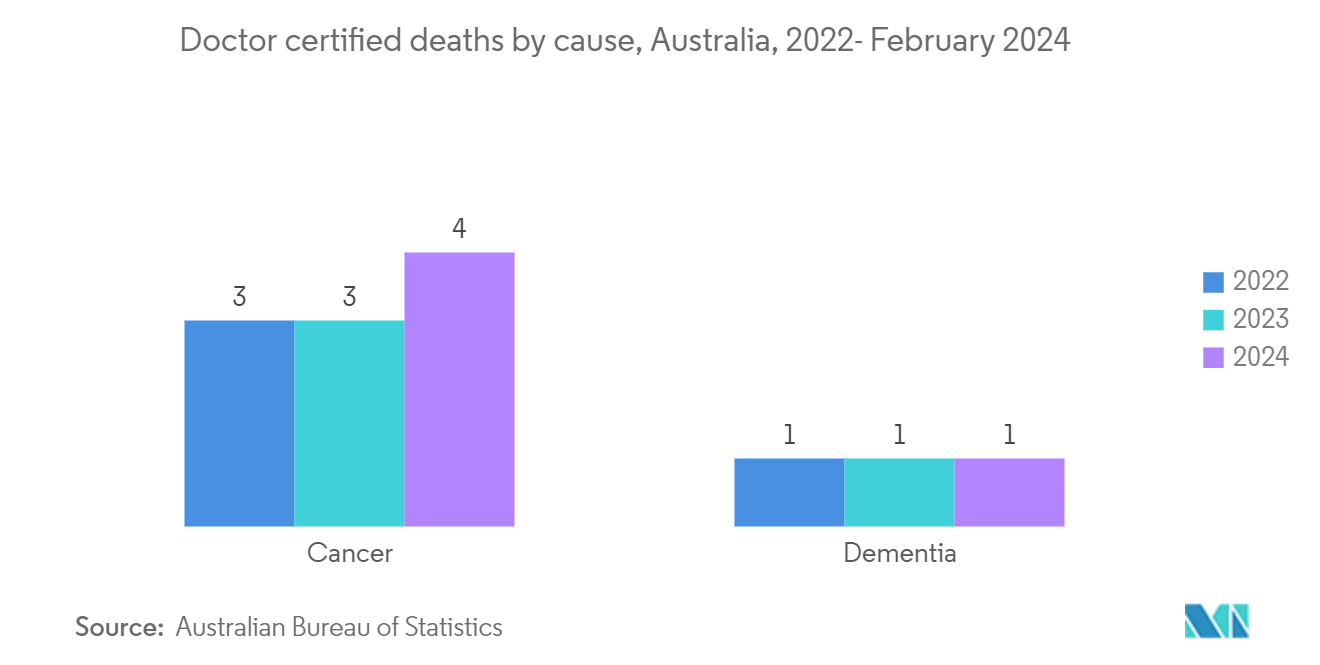
North America to Hold Significant Share
- The North American region is one of the significant consumers of capacitors globally. The medical sector is anticipated to be one of the considerable consumers of capacitors in countries such as the United States, as heart disease and cancer are the country's top two causes of death.
- According to the New York Govt., in the United States, heart disease claims the lives of over 697,000 individuals annually, or 1 in every five fatalities. The most prevalent form of heart disease, coronary heart disease (CHD), claims the lives of over 382,820 people annually. Around 805,000 Americans get a heart attack each year.
- According to a report, around 3 million people use ICDs and pacemakers in the United States. These Implantable cardioverter defibrillators (ICDs), Pacemakers are made up of capacitors. These growing trends of heart diseases will drive the market growth during the projected period.
- The region is witnessing a significant merger and acquisition strategy adopted by major Capacitor Market players. For instance, Cornell Dubilier Electronics announced the acquisition of the capacitor division of NWL through its CD Snow Hill subsidiary. The acquisition allows Cornell Dubilier Electronics to expand its existing portfolio of high-voltage film capacitors for pulsed power and power conversion applications in the industrial, military, and medical markets.
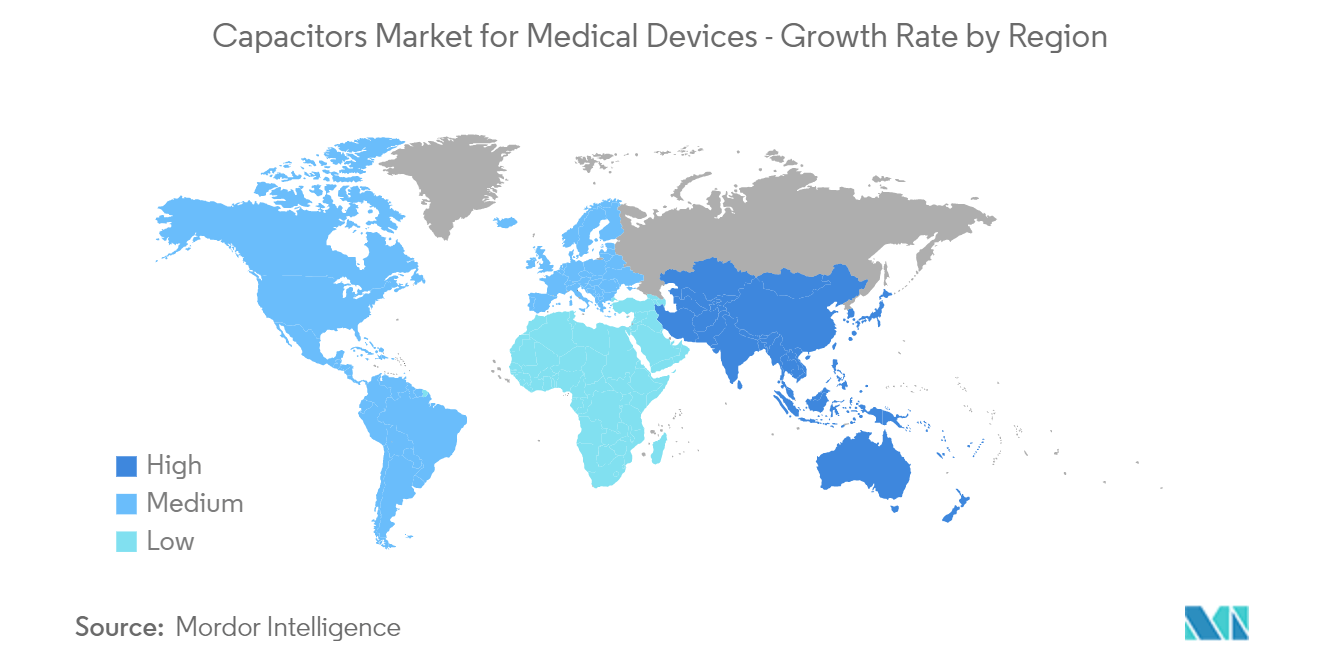
Competitive Landscape
The Capacitors Market for Medical Devices is significantly competitive and fragmented. Several global and local players are operating in the market. Some of the key players are Murata Manufacturing Co. Ltd, Exxelia, Knowles Corporation, AVX Corporation (Kyocera Group), and WIMA gmbh & Co. KG. To remain in the competition, the companies focus on inventing innovative products and collaborations with the other market leaders.
- March 2023 - Murata announced to expand its Silicon Capacitor manufacturing by creating a new 200-mm mass production line in Caen, France. The Silicon Capacitors manufactured by Murata in this factory are used in demanding applications such as implantable medical systems, telecommunication infrastructures, etc.
- March 2022 - KYOCERA AVX announced the acquisition of the tantalum and polymer capacitor business assets of ROHM Semiconductor to further enhance its substantial range of electrolytic capacitor solutions. This acquisition will strengthen the company's product portfolio. It is the top provider of solid tantalum capacitors for use in medical, armed forces applications.
Leaders of Capacitors Market For Medical Devices
-
Murata Manufacturing Co., Ltd.
-
AVX Corporation (Kyocera Group)
-
Knowles Electronics, LLC.
-
WIMA GmbH & Co. KG
-
Exxelia Group
- *Disclaimer: Major Players sorted in no particular order
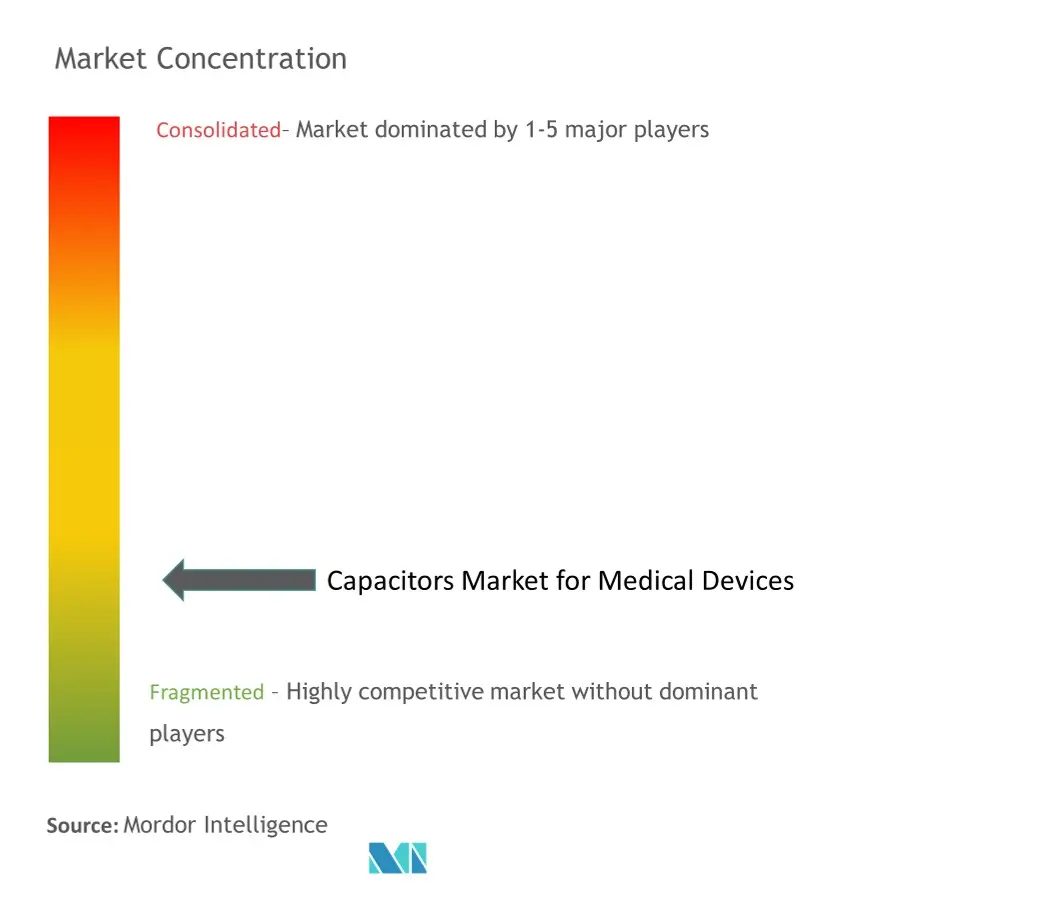
Recent Industry Developments
- April 2023: Researchers from the Indian Institute of Science (IISc)'s Department of Instrumentation and Applied Physics (IAP) have created a small gadget that can store a tremendous electric charge. Compared to current supercapacitors, the revolutionary ultra-micro supercapacitor is more compact and smaller, and it has the potential to be employed in various products, including consumer electronics, electric vehicles, and medical devices.
- November 2022: In order to fit more energy storage into a smaller footprint, Vishay Intertechnology, Inc. has developed a new line of screw-terminal aluminum electrolytic capacitors. The RoHS-compliant devices, which are polarised aluminum electrolytic capacitors with a non-solid electrolyte and a mandated lifetime of 10 to 15 years, are best suited for filtering, buffering, and energy storage in pulsed power applications. Industrial motor drives, rail traction for buses and trains, HVAC and UPS, medical X-ray equipment, wind turbines, and solar power inverters are examples of typical end products.
Scope of Report on Capacitors Market For Medical Devices
A vast variety of electronic systems, including smartphones, home appliances, electric cars, and medical devices, depend on capacitors. High dependability is required for capacitors used in life-supporting and non-life-supporting medical equipment, and they must pass rigorous screening tests. Medical devices, both implanted and not, can employ a variety of passive components. Implantable medical devices have the highest performance requirements, even though all medical applications need small, very reliable capacitors.
The capacitors market for medical devices is segmented by type (ceramic capacitors, aluminum electrolytic capacitors, tantalum capacitors, paper and plastic film capacitor, EDLC, and others (obstetrical, neurology, physical medicine, general and plastic surgery, among others)), by application (cardiovascular, radiology, general hospital, and ENT & dental), and by geography (North America, Europe, Asia-Pacific, and Rest of the World). The market sizes and forecasts are provided in terms of value in USD for all the above segments.
| Ceramic Capacitors |
| Tantalum Capacitors |
| Aluminum Electrolytic Capacitors |
| Paper and Plastic Film Capacitor |
| EDLC and others |
| Cardiovascular |
| Radiology |
| General Hospital |
| ENT and Dental |
| Others (Obstetrical, Neurology, Physical Medicine, General and Plastic Surgery, etc.)) |
| North America |
| Europe |
| Asia |
| Australia and New Zealand |
| Latin America |
| Middle East and Africa |
| By Type | Ceramic Capacitors |
| Tantalum Capacitors | |
| Aluminum Electrolytic Capacitors | |
| Paper and Plastic Film Capacitor | |
| EDLC and others | |
| By Application | Cardiovascular |
| Radiology | |
| General Hospital | |
| ENT and Dental | |
| Others (Obstetrical, Neurology, Physical Medicine, General and Plastic Surgery, etc.)) | |
| By Geography | North America |
| Europe | |
| Asia | |
| Australia and New Zealand | |
| Latin America | |
| Middle East and Africa |
Key Questions Answered in the Report
How big is the Medical Devices Capacitors Market?
The Medical Devices Capacitors Market size is expected to reach USD 1.30 billion in 2025 and grow at a CAGR of 4.20% to reach USD 1.60 billion by 2030.
What is the current Medical Devices Capacitors Market size?
In 2025, the Medical Devices Capacitors Market size is expected to reach USD 1.30 billion.
Who are the key players in Medical Devices Capacitors Market?
Murata Manufacturing Co., Ltd., AVX Corporation (Kyocera Group), Knowles Electronics, LLC., WIMA GmbH & Co. KG and Exxelia Group are the major companies operating in the Medical Devices Capacitors Market.
Which is the fastest growing region in Medical Devices Capacitors Market?
Asia Pacific is estimated to grow at the highest CAGR over the forecast period (2025-2030).
Which region has the biggest share in Medical Devices Capacitors Market?
In 2025, the North America accounts for the largest market share in Medical Devices Capacitors Market.
What years does this Medical Devices Capacitors Market cover, and what was the market size in 2024?
In 2024, the Medical Devices Capacitors Market size was estimated at USD 1.25 billion. The report covers the Medical Devices Capacitors Market historical market size for years: 2019, 2020, 2021, 2022, 2023 and 2024. The report also forecasts the Medical Devices Capacitors Market size for years: 2025, 2026, 2027, 2028, 2029 and 2030.
Page last updated on:
Report on Capacitors Market For Medical Devices
Statistics for the 2025 Capacitors For Medical Devices market share, size and revenue growth rate, created by Mordor Intelligence™ Industry Reports. Capacitors For Medical Devices analysis includes a market forecast outlook for 2025 to 2030 and historical overview. Get a sample of this industry analysis as a free report PDF download.
